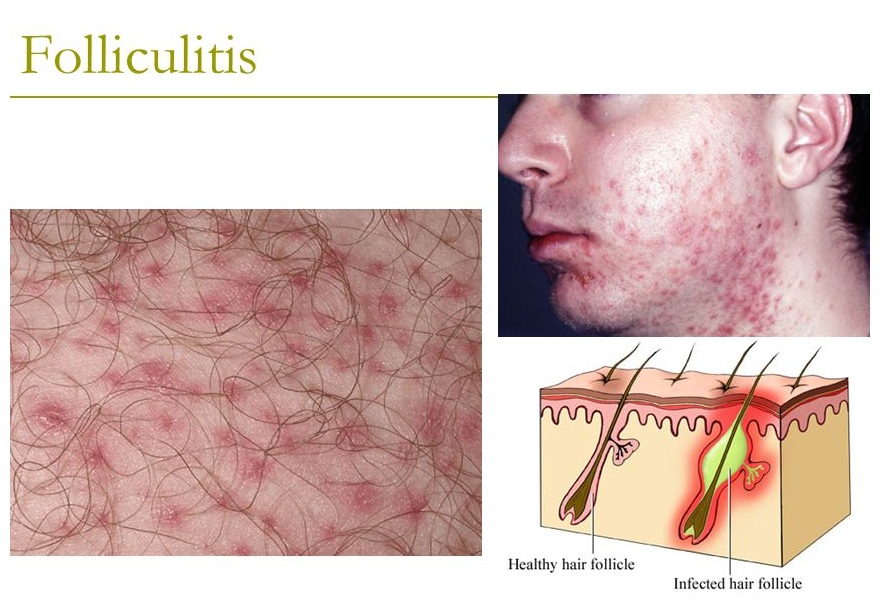What is Folliculitis?
Table of Contents
Each of the hairs on your body grows inside of a follicle. From time to time, these follicles can become inflamed due to infection or other causes. Folliculitis is the inflammation of one or more of the hair follicles on the body. It can be just one or cover an entire area such as; the back, the legs, the buttocks, the arms, neck and chest. (See Figure 1)
Figure 1: Folliculitis
Photo Courtesy of: natural-homeremedies.com
Folliculitis is often seen in the areas that are covered by restrictive clothing. Underwear areas, armpits and neck areas are the most affected. Rarely, Folliculitis will affect the face and the scalp areas. This can be devastating for the sufferer due to drastic changes in appearance. Especially since the most commonly affected are adolescent and older children. It is also common in diabetic patients, HIV patients and others with compromised immune systems.
Folliculitis when widespread can have the appearance of severe acne. It causes multiple red colored lesions on the skin. These bumps appear anywhere there is hair, so they are extremely visible. They do not occur on the palms of the hands or soles of the feet since there are no hair follicles in these areas.
One type of teenage acne is believed to actually be a type of Folliculitis. The treatment is generally the same for either of the conditions, but it can be emotionally devastating due to changes in appearance. The break-outs can be quite dramatic in more severe cases. This is especially true with young men who have just started shaving. Good shaving techniques and good hygiene need to be taught to help prevent the condition.
What Causes Folliculitis?
Bacterial infection is the most common cause of Folliculitis. Staph is a resident bacteria on the skin and if it enters the follicle then it can cause infection. Grooming habits such as; shaving, poor hygiene and tight clothing can contribute to Folliculitis by making tiny cuts or rubbing, so the bacteria can enter the follicle.
Occasionally, sitting in a hot tub or sauna can cause Folliculitis. This is due to the bacteria pseudomonas aeruginosa that lives in warm areas. Make sure that any hot tubs or saunas are thoroughly cleaned before and after each use. Always shower after using these facilities.
Hair can curve back around and irritate the follicle and cause Folliculitis. This is commonly known as “ingrown hair.†This is common among black males with curly hair and a common cause of facial Folliculitis. Beard hair is much shorter, courser and can irritate sensitive facial skin. Women can get “razor burn†when shaving the legs and this can cause a form of Folliculitis. This is why good grooming and shaving habits are very important in the prevention of this condition. (See Figure 2)
Figure 2: Ingrown Hair
Photo Courtesy of: drlindirect.com
Skin scrapings and wound cultures of pus are used to diagnose Folliculitis. Most physicians can spot it easily with a trained eye. Usually, diagnostic testing is only performed in cases of chronic Folliculitis to identify the organism or cause. Even if Folliculitis is misdiagnosed as a pimple, you should be okay because the treatments are generally the same for both.
How Is Folliculitis Treated?
Usually, Folliculitis is well treatable with just plain antibacterial body wash or acne wash preparations. It is best to use an acne wash that contains benzoyl peroxide and/or salicylic acid. If the infection seems too advanced or does not clear with body wash, the physician will order oral antibiotics to be taken. Broad spectrum antibiotics that reach the skin easily are the most commonly used and sometimes need to be taken long-term with chronic cases. There are also antibiotic skin creams that can be prescribed by a dermatologist for long-term use. Some cases can be very stubborn and hard to treat.
If Folliculitis is persistent and keeps returning, the patient may be referred to a dermatologist (skin specialist) for culture and scraping of the lesions. This is done to find the causative organism and determine the best medication to treat the rash. For example, a fungal skin infection will only respond to antifungal medications, etc. Doctors skilled with medical lasers can zap the follicles that are persistently infected. This procedure not only stops the infection, but also hair growth. (See Figure 3)
Figure 3: Laser Treatment for Folliculitis
Photo Courtesy of: hairremovalcentre.co.uk
If the rash is due to high blood sugar in diabetics or compromised immune system, then the patient will be referred out to their treating doctor for that condition to evaluate and bring any underlying disorders under control.
Folliculitis that is persistent can be a message from the body that something isn’t quite right. Many times the condition will not clear up until certain body functions are corrected. The only complication is diabetics that get Folliculitis are at higher risk of life threatening infections and need to have this condition treated promptly. Diabetics need to take extra care, especially if it is near diabetic sensitive areas like the legs or the feet.
Conclusion
For the most part, Folliculitis is very easy to treat in most cases and usually does not return. It is important that if you have signs of Folliculitis to begin treatment as soon as possible so the rash does not spread. There are usually no complications of Folliculitis and good hygiene and shaving techniques need to be practiced to avoid the condition. The only risks for severe complications are with diabetics that need to avoid skin infection near the leg and feet areas.
Just remember to keep your skin clean and dry. Wear loose clothing and let your skin breathe. Use good high quality face or acne wash products and if the rash does not clear up within a few days or is accompanied by other symptoms, it should be evaluated by a physician.

